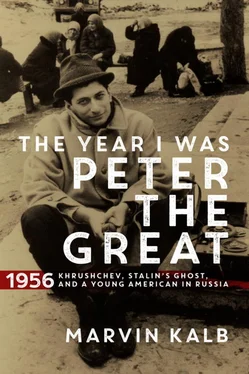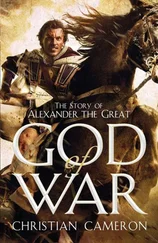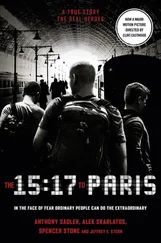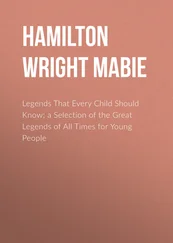The same evening, in Moscow, Soviet leaders met in a frenzy of anxiety and fear. “Hungary is coming apart,” cried Molotov. “The government is being overthrown,” wailed Lazar Kaganovich. “It’s not the same as Poland,” observed Zhukov. “Troops must be sent.” Everyone agreed, with the exception of the veteran communist negotiator Anastas Mikoyan. He argued for patience, suggesting that the Hungarians “restore order on their own.” Khrushchev, fighting to protect his endangered policy of de-Stalinization, joined his other colleagues in their decision to send troops into Budapest and also to send Mikoyan and the Kremlin’s chief ideologue, Mikhail Suslov, to Budapest to monitor the mess.
Very early the next morning, on October 24, Soviet troops invaded Budapest. A force of some 10,000 troops, supported by eighty tanks, rolled into the capital from their bases in the countryside. It was a rare show of Soviet efficiency, triggered by the fear that, as Molotov had warned, Hungary was “coming apart.” Russian generals initially believed that their troops could contain the crisis, but after only a few hours it was clear that they had only inflamed it. Hungarian students threw Molotov cocktails at the tanks. The Russians fired at the rebels, starting a flow of blood that inspired those Hungarians sitting on the sidelines to take up arms and join the rebellion. The Kremlin quickly learned that the bonds of blood and nationalism were thicker than those of communist allegiance. According to one estimate, by midafternoon twenty-five students had been killed and 200 wounded. That was the estimate in Budapest. There was none for those killed in other parts of Hungary.
I noted in my diary that “Hungary had just ripped a page out of Poland’s recent history and stolen the headlines from Gomulka.” Just from the Soviet press, rarely a reservoir of reliable information, we learned that Hungarian rebels were demanding that Nagy replace Gero and press his plans for reform. At Moscow’s direction Nagy did in fact replace Gero, but, like Gero, he also distrusted the student rebels. What were their true intentions? Nagy, as a Moscow-trained communist, wanted only to reform the Hungarian system of government, not to overthrow it, as many students demanded.
At JPRS and at the embassy we were being inundated with reports from Hungary, some reliable but many less so. One said that Soviet aircraft had opened fire on insurgent “mobs.” At the time there was no confirmation of this. Another report, from Budapest Radio, said that Hungarian wives were appealing to their husbands to stay at home and “amuse” themselves with domestic “activities,” which were left undefined. The point was to keep them from joining the student rebels. Still another report said that miners in two towns fifty to sixty miles from Budapest had joined the uprising, shutting down their mines and taking up arms against government troops. Again there was no confirmation, but the report strongly suggested that the rebellion was already spreading into the provinces.
We also heard that many rebels were now calling for “true national independence” and free elections—elections involving more than one party. Nagy, their hero in the early days of the revolt, took an interesting but puzzling approach to these rebel demands. While the demonstrators were hurling Molotov cocktails at Soviet tanks and troops, clearly seeing them as enemies of their revolt, Nagy appealed to the demonstrators to show “love and kindness” to the invading Soviet troops, suggesting that, even in these early days, the new prime minister was already losing touch with the fiery goals of the student-led uprising. Nagy favored the Soviet intervention, hoping it would restore calm. His goal was always reform; the students wanted revolution.
Often, when I got tired of official statements, even those uttered by American diplomats, I would turn down the embassy limo and jump into a cab for the ride back to American House. I wanted to hear a Russian discuss events in Hungary. Of course not all cabdrivers were talkative, but some of them were. On this evening the driver asked me whether I had “fresh information” about Hungary. Before I could answer, he launched into his own analysis. “Whose side are the Hungarian troops on?” That was the key to his analysis. “If you know anything about our revolution, you recall that success came to us when the troops joined the insurgents. This is the critical question.” It was my pleasure to inform him that many Hungarian troops were in fact joining the insurgents; according to one report they had seized a Soviet airfield and burned the planes and hangars. When we reached American House, I tried to pay him for the ride. He waved his hand and shook his head, refusing payment. “Thank you,” he said, with a smile, emphasizing the word “you.”
One can imagine that Khrushchev had trouble sleeping for much of the next week. “Budapest was like a nail in my head,” he later recalled. He had ordered troops into Budapest but the rebellion continued, the fighting spread, and Russian casualties mounted. (He did not care about Hungarian casualties.) Lenin’s haunting question, Chto delat’? —What is to be done?—was the essential dilemma for Khrushchev. Indeed, what was to be done? He was in a quandary, uncertain about his next step.
The upshot was that his policy swung from one extreme to another, “lurch[ing] from surrender to bloodbath,” to quote one of his biographers, William Taubman. One day he would urge his colleagues to “face facts.” “There is no firm leadership there, either in the party or the government…. Their troops may go over to the rebels.” He argued that the Soviet Union had “no alternative” but to support the wobbly regime in Budapest. Zhukov, after surveying military options, flip-flopped, stunning his colleagues by changing his position from intervention to withdrawal, stating, “We should withdraw our troops from Budapest, and from all of Hungary, if that’s demanded.”
On October 30 Khrushchev seized on the Zhukov proposal, using it as a military shield against political criticism. “We are unanimous,” he proclaimed. “There are two paths, a military path, one of occupation, and a peaceful path—the withdrawal of troops, negotiations.” He obviously preferred the peaceful path, at least at the moment he spoke. In this crucial week he was given to sudden changes of mind, heart, and policy. Surprising everyone, he even approved a remarkable TASS statement admitting “egregious mistakes” by the Kremlin, including “violations of the principles of equality in relations with socialist countries” and adding a pledge “to observe the full sovereignty of each socialist state.”
Reading such an official admission of “mistakes” and “violations,” in the midst of an anti-communist revolution in an East European satellite, what was the average Russian to think about his own government’s policies? What was a communist official in the hinterlands to think? What was the U.S. embassy to think? At this revealing moment, all might have thought that the Khrushchev regime had been thrown into confusion and uncertainty by the startling events in Hungary and that it did not know what to do—and they would all have been right.
But then, in Budapest, as Nagy moved closer to supporting the rebels’ ultimate demand for “true national independence,” an anguished Khrushchev again changed his mind. He did not want to be seen as just another Stalin, using military force when political negotiations might have made more sense. In his memoirs he referred to the late dictator’s prediction that without him, Russia would collapse into uncontrollable chaos. “You are blind like little kittens,” Stalin had jokingly warned. “Without me the imperialists would strangle you.” The imperialists were always a handy villain.
Читать дальше












